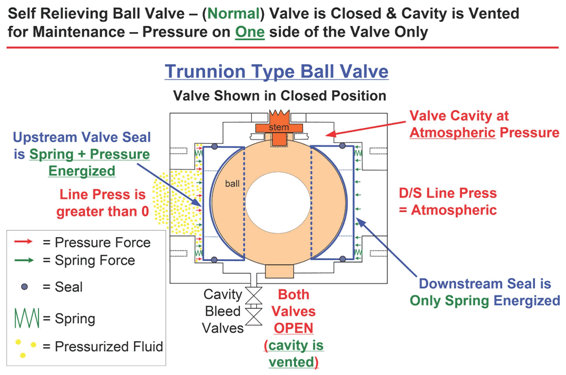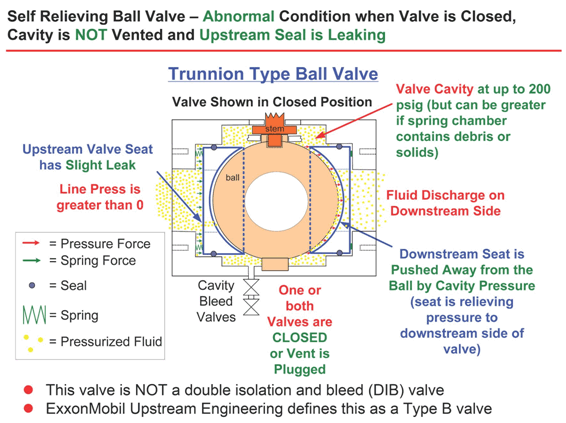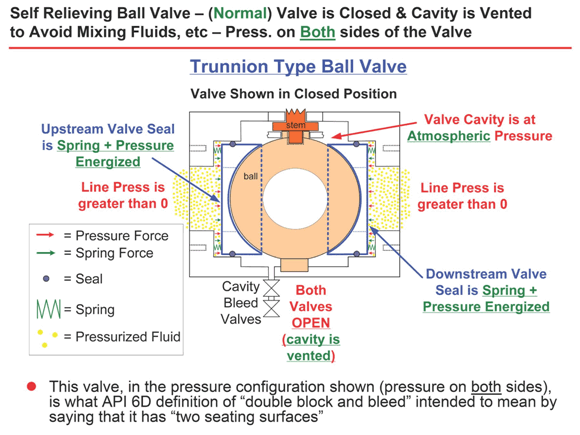True meaning of
Double Block & Bleed
On March 4 2010 Garza, Mechanical Lead - Static Equipment Engineering Group at ExxonMobil Development Company, gave a presentation at the VMA Technical Seminar in San Antonio entitled "Isolation Philosophies" in which he asserted that many people take the term "Double Block and Bleed" (DBB) to mean the same thing as Double Positive Isolation" (DPI). While this may seem like a small matter, he says, it means that some users may think they've achieved positive isolation when they haven't. Part of the problem, he goes on, is that designers and users don't always understand the capabilities of the Valves in question. And, he adds, the design of a particular Valve can vary from one manufacturer to another.
Garza stresses that his presentation shouldn't be taken as holy writ, but as how his particular branch of ExxonMobil (i.e. Upstream) looks at the situation in its own industry and the practices it uses. Other companies (including within ExxonMobil) and industries may do things differently and it is up to the users to determine the safety and suitability of a particular practice to their application, he says.
The key message is that a user should look at the design of a particular Valve, and find out exactly what the manufacturer means by the term "double positive isolation" or "double block and bleed.", to make sure it's really what's needed in a particular application.
Many users, says Garza, have taken "double block and bleed" as a generic term, and tend to use it when they really mean (and the applicable specification API 6D, Specification for Pipeline Valves, requires) the use of double isolation and bleed. The key to understanding, Garza says, can be found in API 6D. That specification wasn't always as clear as it could have been in spelling out the difference between DBB and DPI, but the addition in 2008 of several notes has clarified it.
API 6D defines a double-block-and-bleed Valve (DBB) as a "single Valve with two seating surfaces that, in the closed position, provides a seal against pressure from both ends of the Valve with a means of venting/bleeding the cavity between the seating surfaces." The 2008 note points out that this Valve does not provide positive double isolation when only one side is under pressure.
By contrast, API 6D defines a double-isolation-and-bleed Valve (DIB) as a "single Valve with two seating surfaces, each of which, in the closed position, provides a seal against pressure from a single Reference(s), with a means of venting/bleeding the cavity between the seating surfaces. The note adds that this feature can be provided in one direction or in both directions.
The job of a double isolation and bleed is to stop process fluid from getting into an area where work is being done. Both in-line Valves would be closed, then the bleeder would be opened. If any fluid leaked past the first Valve the bleeder would drain it off before it pressurized the cavity - the space between the upstream and downstream Valves, and at the same time would act as a tell-tale to indicate the leakage. If the bleeder (which is smaller than the in-line Valves and may, in fact, be a needle Valve) were to be plugged the downstream Valve would keep process fluid from getting past it.
So why is the difference between DBB and DIB important? Let's consider a typical trunnion-mounted Ball Valve with self-relieving seats. API 6D defines this as a double block and bleed Valve, not a double isolation and bleed Valve. Under normal conditions (Figure 1) there is pressure on the upstream seal, which (along with an internal spring) keeps it energized. There's no pressure on the downstream side, so the only thing energizing the seal on that side is a spring. The bleeder Valves are open, and the cavity in the ball is at atmospheric pressure.
In this trunnion-mounted Ball Valve with self-relieving seats (which API 6D defines as a double block and bleed) there is pressure on the upstream seal, but no pressure on the downstream side, so the only thing energizing the seal on that side is a spring.
Figure 1

But it's not uncommon for a Valve that's been in service for a while to leak a bit. Figure 2 (see end of article) shows what happens then. The upstream seal is leaking a little, but this should not be a problem because the leakage will be carried away by the bleeder, except when the bleeder is not working, either because one or both of the bleeder Valves is closed, or because there's a clog in the bleed line. The pressure in the Valve cavity can then possibly reach as high as 200 psi, which overcomes the spring on the downstream seal and forces it off its seat, discharging fluid downstream to where people may be working. This is clearly not a double isolation and bleed Valve.
So where should this type of Valve be used ? Figure 3 (see end of article) shows a situation that might occur when the Valve is used in a bypass loop for proving a flowmeter, for example. The Valve is closed and the bleeder is open. This time there is pressure on both the upstream and downstream seals, keeping them fully energized. This is the configuration that the API 6D definition of "double block and bleed" intended when it referred to "two sealing surfaces." But it's not true double positive isolation and bleed, as far as ExxonMobil Upstream is concerned, and in certain services, it shouldn't be used to isolate a section for maintenance.
Sorting Valves by type
Table 1 Example Valve type classifications
| Type | EM Class |
| Ball - Floating | A |
| Ball - Trunnion, SRS | B* |
| Ball - Trunnion, DPE | B* |
| Ball - Rising Stem | A |
| Globe - (Excluding Control Valves) | A |
| Plug - Standard | A |
| Plug - Mechanically Energized Seats | C |
| Gate - Expanding | C |
| Gate - Slab | B |
| Gate - Sliding | A* |
| Gate - Solid Wedge | B* |
| Gate - Unported Flexible Wedge | B |
| Butterfly (all types) | A |
To prevent confusion ExxonMobil Upstream sorts Valves into four categories A, B, C and D the physical flow blocking capabilities of the Valve and then provides guidance based on the minimum isolation requirements for a particular application, such as long vs. short term, segregation for meter proving, etc.
Type A is a single block Valve with a single mechanically energized seal and no body bleed required.
Type B is a double block and bleed (as defined in API 6D, but not always by industry). It requires pressure on upstream and downstream sides simultaneously to energize the respective seals. It's the type shown in Figures 1 (see above) through 3 (see end of article).
Type C is a true double isolation and bleed (DIB) per API 6D. The Valve is a single body with dual positive seals; it has a single obturator (gate, plug, etc) and dual positively energized seals (upstream and downstream) with cavity bleed port between them. It requires a cavity overpressure protection device in expansive fluid services.
* Denotes potential for exceptions based on configuration of Valve and/or manufacturer "SRS" = self relieving seats; "DPE" = double piston effect seats
Table 2 is a generic example of a filled-in requirements table. Usually there's a temperature threshold (T1, T2, etc), then a fluid characterization (flammable, non-flammable, etc.), then a pressure class (All, C1, C2, etc.), and then a size range (All, D1, D2, etc.). On the far right is the type of Valve designated for that particular service (A, B, C or D). The application of the table is driven primarily by the individual facility's "isolation philosophy." The Valve Type shown is risk and experience based, and it requires well documented definitions (management endorsed) for each type of Valve (including variations thereof). In addition, the definition of "flammable" and "toxic" is likely to vary by company and/or location.
Type D is a true double positive isolation and bleed Valve arrangement, with two independent obturators (sealing members) in the same or separate bodies and two separate actuating mechanisms (i.e. independent stems). It can be made up of a pair of certain Type A, B, or C Valves, either separate or built into one body. It must have a bleeder in the middle (between the two Valves and between each Valve's seals if Type C Valves are used).
Table 2 Sample positive isolation format
| Fluid Design Temp | Fluid (e.g.) | Pressure or Class | Size (NPS) | Min. Valve Type (e.g.) |
| Isolation for Condition 1 (e.g. Long-Term Maintenance) | ||||
| ≤T1 | flam. | All | All | D |
| Non flam. | >C1 | All | D | |
| ≤C1 | All | B | ||
| >T1 | flam. | All | All | D |
| Non flam. | >C2 | All | D | |
| ≤C2 | All | B | ||
| Isolation for Condition 2 (e.g. Short-Term Maintenance) | ||||
| >T1 | All | All | All | D |
| ≤T2 | Toxic and highly corrosive materials | All | All | C |
| Flam. materials | ≤C3 | All | B | |
| C4, C5 and C6 | ≤D1 | B | ||
| Instr. conn. with flam. materials | ≤C7 | ≤D2 | B | |
| >C7 | ≤D2 | D | ||
| Water, air and other non-flam. | ≤C8 | ≤D3 | A | |
| >C8 but ≤C9 | All | C | ||
| All | ≥C10 | All | D | |
| Isolation for Condition 3 (e.g. meter provers) | ||||
| All | Specify as needed | All | All | B |
| Isolation for Condition 4 (etc.) | ||||
| All | Specify as needed | All | All | D |
Note.. A "blind" can be substituted as one of the isolation points (i.e. 1 of 2 in DIB)
Remember that local regulations vary and must be kept in mind when making any Valve selection.
Summary
Garza is quick to point out that the Type A, B, C and D designations are not aligned with the API 6D classifications or those of other industry standards, and are simply practices that ExxonMobil Upstream has adopted for its own use, but they bring out an important point.. although block Valves can stop flow, the way in which they achieve this varies and hence when specifying a Valve for isolation service, don't inadvertently use a double block and bleed Valve when you really need a double isolation and bleed type.
Reach Peter Cleveland at pcleaveland@earthlink.net. This e-mail address is being protected from spambots. You need JavaScript enabled to view it . A longer version of this article will appear in a future issue of Valve Magazine. All images are courtesy of Rudy Garza and ExxonMobil Development Company.
Figure 2
If the upstream seal should leak, and the bleeder is closed or clogged, the pressure in the Valve cavity can overcome the spring on the downstream seal and force it off its seat, discharging fluid downstream to where personnel may have the piping opened for maintenance.

Figure 3
This type of Valve is best used where there is pressure on both the upstream and downstream seals, keeping them fully energized, as in a bypass loop for proving a flowmeter, for example. This is the configuration that the API 6D definition of "double block and bleed" intended when it referred to "two sealing surfaces," but it's not double positive isolation, as far as ExxonMobil Upstream is concerned, and it shouldn't be used to isolate a section for maintenance.
